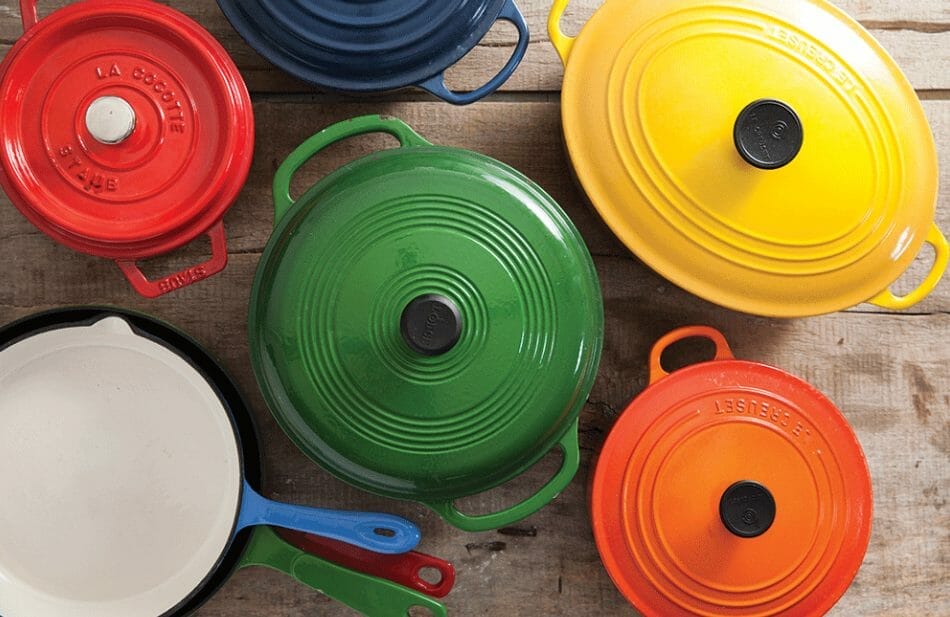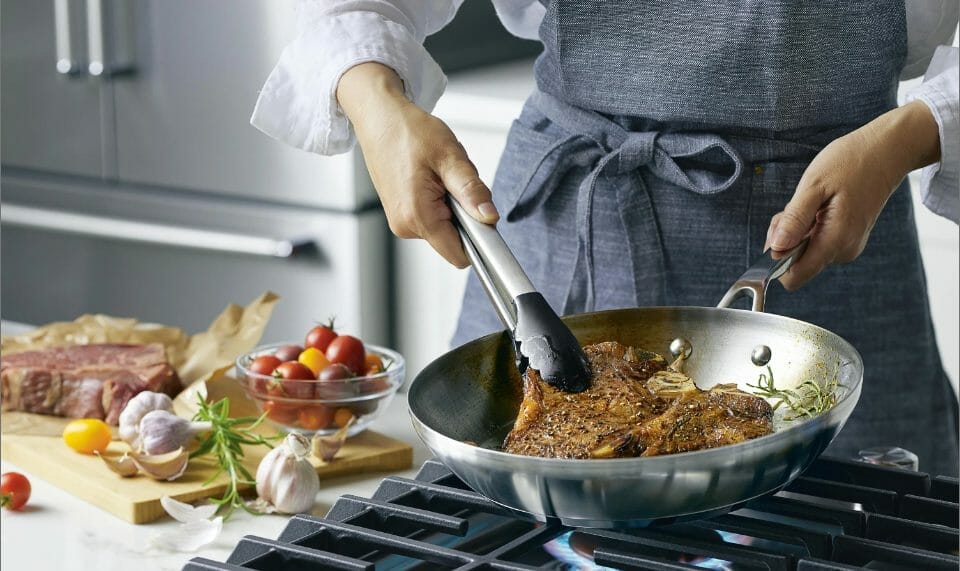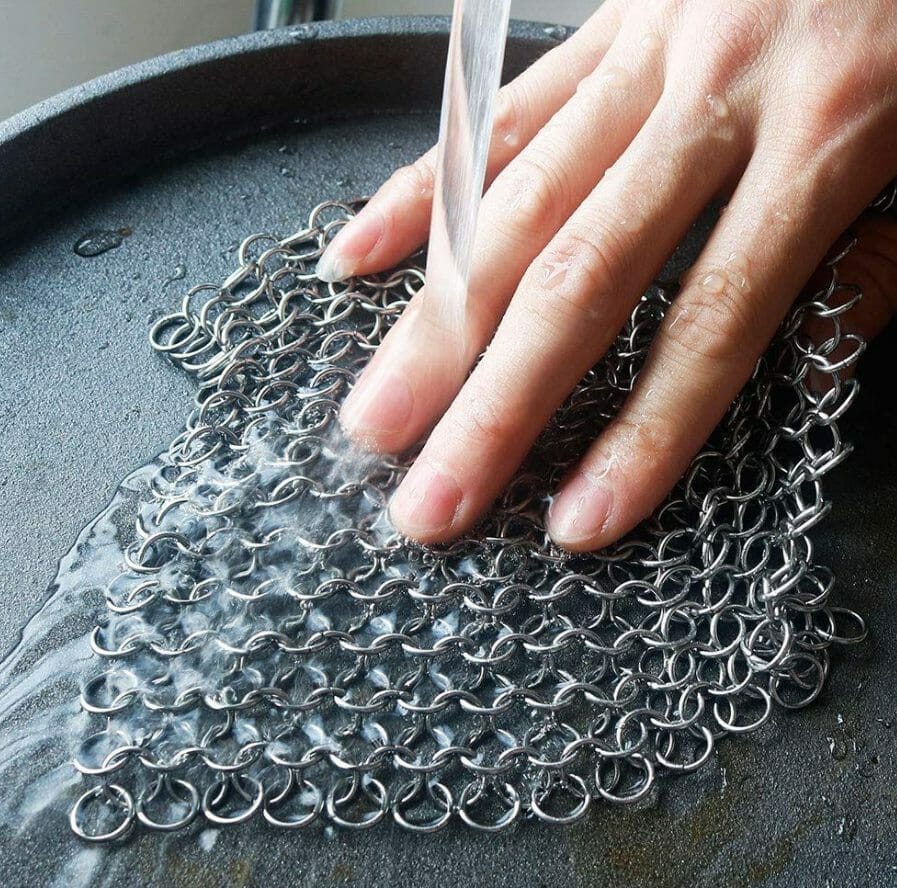Welcome to our comprehensive guide comparing the two popular materials used in cookware: enameled cast iron and stainless steel. Whether you’re a seasoned cook or a beginner in the kitchen, choosing the right cookware can make a significant difference in your culinary adventures. In this article, we will delve into the key differences between enameled cast iron and stainless steel, helping you make an informed decision based on your cooking needs and preferences.
Before we explore the specific features and benefits of these materials, let’s understand the basics. Enameled cast iron is a type of cookware made from cast iron and coated with a layer of enamel. This coating adds durability, prevents rusting, and provides an attractive aesthetic appeal. On the other hand, stainless steel is a versatile alloy composed of iron, chromium, and other metals, known for its strength and resistance to corrosion.
Throughout this guide, we’ll discuss various factors such as heat distribution, durability, non-stick properties, cleaning and maintenance, price, and availability. By the end, you’ll have a clear understanding of which material aligns best with your cooking style and requirements.
Understanding Enameled Cast Iron
When it comes to choosing the right cookware material, enameled cast iron is a popular option that offers both functionality and style. Enameled cast iron cookware is made by coating a cast iron core with a layer of enamel, a type of glass-like material. This combination of cast iron and enamel creates a durable and versatile cooking surface.

The process of making enameled cast iron involves first melting iron and pouring it into molds to create the desired cookware shape. Once the cast iron has cooled and solidified, a layer of enamel is applied to the surface. The enamel is typically made from a powdered glass mixture that is fused to the cast iron through a high-temperature firing process.
Enameled cast iron offers many benefits for cooking. Its thick and heavy construction allows for excellent heat retention, ensuring even cooking and preventing hot spots. The enamel coating provides a smooth and non-reactive surface, making it ideal for cooking acidic foods like tomatoes and citrus-based dishes. Additionally, the enamel finish is available in a wide range of colors, adding a touch of style to your kitchen.
However, there are a few drawbacks to consider when using enameled cast iron cookware. The enamel coating can be prone to chipping or cracking if the cookware is dropped or mishandled. It is also not suitable for high-temperature cooking methods, such as searing or broiling, as the enamel may degrade under extreme heat.
Exploring Stainless Steel Cookware
Stainless steel cookware is a popular choice among home cooks and professional chefs alike. Its durability, versatility, and sleek appearance make it a staple in many kitchens. But what exactly is stainless steel and what sets it apart from other cookware materials?
Stainless steel is an alloy made primarily from iron, with the addition of chromium and other metals. This combination creates a material that is resistant to rust and corrosion, making it ideal for cookware that comes into contact with water and acidic ingredients. The chromium content in stainless steel forms a protective layer on the surface, preventing oxidation and ensuring the cookware’s longevity.

One of the key advantages of stainless steel cookware is its ability to distribute heat evenly. The material’s excellent conductivity allows for consistent heat distribution across the entire cooking surface, eliminating hot spots that can result in unevenly cooked food. This ensures that your dishes are cooked to perfection every time.
Another benefit of stainless steel cookware is its non-reactive nature. Unlike some other materials, stainless steel does not react with acidic or alkaline ingredients, meaning it won’t alter the taste or color of your food. This makes it a great choice for cooking a wide range of recipes without any unwanted side effects.
While stainless steel does offer many advantages, there are a few drawbacks to consider. Stainless steel cookware can be prone to sticking if not properly seasoned or if the heat is too high. To prevent sticking, it is often recommended to preheat the pan and use adequate amounts of cooking oil or butter. Additionally, stainless steel cookware can be heavier compared to other materials, which may require some adjustment in handling and storage.
In summary, stainless steel cookware is a durable and versatile option for your kitchen. Its ability to distribute heat evenly, non-reactive nature, and resistance to corrosion make it a reliable choice for everyday cooking. Just remember to season the cookware properly and adjust to its weight, and you’ll be well on your way to creating delicious meals with stainless steel cookware.
Heat Distribution and Retention
When it comes to heat distribution and retention, both enameled cast iron and stainless steel cookware have their unique properties.
Enameled cast iron is known for its ability to distribute heat evenly. The thick and heavy construction of the material allows for excellent heat retention, which is especially beneficial for slow cooking or braising dishes. The heat spreads consistently across the surface, ensuring that food cooks uniformly.

On the other hand, stainless steel is a poor conductor of heat compared to cast iron. However, stainless steel cookware often features an aluminum or copper core, which enhances heat distribution and allows for more precise temperature control. This can be advantageous for dishes that require quick and precise changes in heat.
Overall, enameled cast iron excels in heat retention and even cooking, while stainless steel with a core offers improved heat distribution for more controlled cooking.
Durability and Longevity
When it comes to durability and longevity, both enameled cast iron and stainless steel cookware have their own strengths and considerations.
Firstly, enameled cast iron is known for its exceptional durability. The cast iron core provides a solid and sturdy construction, making it resistant to cracks, dents, and warping. The enamel coating adds an extra layer of protection, preventing rust and corrosion.

However, it’s important to note that the enamel coating can chip or crack over time, especially if the cookware is subjected to rough handling or extreme temperature changes. This can compromise the longevity of the cookware and necessitate replacements or repairs.
On the other hand, stainless steel cookware is also highly durable. It is resistant to corrosion, rust, and staining, making it suitable for long-term use. Stainless steel has a reputation for being tough and resilient, retaining its sleek appearance even after years of use.
That being said, stainless steel can develop scratches and scuff marks with regular use, especially if abrasive cleaning tools are used. While these cosmetic blemishes do not affect the performance of the cookware, they might bother those who prefer their cookware to look brand new at all times.
To ensure the longevity of both enameled cast iron and stainless steel cookware, proper care and maintenance are essential. Avoid using metal utensils with enameled cast iron to prevent scratching the enamel, and hand wash to avoid exposing it to harsh dishwasher detergents. For stainless steel, use non-abrasive cleaners and utensils to preserve the finish.
Ultimately, the durability and longevity of your cookware will depend on your cooking habits, cleaning routines, and overall care. With proper attention, both enameled cast iron and stainless steel cookware can last for many years, making them worthwhile investments for any kitchen.
Non-Stick Properties
When it comes to non-stick properties, both enameled cast iron and stainless steel cookware have their own advantages and considerations. Let’s take a closer look at how they compare.

Enameled Cast Iron:
Enameled cast iron cookware is known for its excellent natural non-stick properties. The enamel coating creates a smooth and slick surface that helps prevent food from sticking, making it easier to cook, serve, and clean up. This makes it a popular choice for dishes that require gentle cooking or browning, such as stews, roasts, and braises.
However, it’s important to note that enameled cast iron cookware may require some additional care to maintain its non-stick surface. It is recommended to avoid using metal utensils, as they can potentially scratch the enamel coating. Instead, opt for wooden or silicone utensils that won’t damage the surface.
Stainless Steel:
Stainless steel cookware, on the other hand, does not have natural non-stick properties. While it can be used for a variety of cooking techniques, such as sautéing, boiling, or frying, it may require the use of oils or fats to prevent food from sticking to the surface.
To enhance the non-stick properties of stainless steel cookware, some manufacturers offer pans with non-stick coatings. These coatings are typically made from materials like Teflon or ceramic and provide an additional layer of protection against sticking. However, it’s important to follow the manufacturer’s instructions for proper use and care of these coated pans.
In summary, enameled cast iron cookware generally offers a superior non-stick experience compared to stainless steel. However, with proper seasoning and the use of non-stick coatings, stainless steel can also provide satisfactory results.
Cleaning and Maintenance

Maintaining the cleanliness and condition of your cookware is essential for optimal performance and longevity. Here are some tips and guidelines for cleaning and maintaining enameled cast iron and stainless steel cookware:
Cleaning Enameled Cast Iron
When cleaning enameled cast iron, it is important to avoid using abrasive cleaners or brushes that can damage the enamel coating. Instead, follow these steps:
- Allow the cookware to cool down before cleaning.
- Use warm water, mild dish soap, and a soft sponge or cloth to gently clean the surface.
- If there are stubborn food residues, let the cookware soak in warm soapy water for a while, then gently scrub with a non-abrasive sponge or brush.
- To remove any stains, make a paste with baking soda and water, apply it to the stained areas, and let it sit for a few minutes before rinsing.
- Avoid using metal utensils when cooking with enameled cast iron to prevent scratching the enamel surface.
- After cleaning, thoroughly dry the cookware to prevent moisture buildup and potential rusting.
Cleaning Stainless Steel
Stainless steel cookware is generally easier to clean, but it can still require some care to maintain its shine and performance. Follow these steps to clean your stainless steel cookware:
- Allow the cookware to cool down before cleaning.
- Use warm water, mild dish soap, and a soft sponge or cloth to clean the surface.
- If there are food residues stuck to the cookware, fill it with warm soapy water and let it soak for a while before scrubbing with a non-abrasive sponge or brush.
- To remove any stubborn stains or discoloration, create a paste with baking soda and water, apply it to the affected areas, and gently scrub.
- Avoid using harsh cleaners or bleach as they can damage the stainless steel surface.
- To maintain the shine, wipe the cookware dry after cleaning to prevent water spots or mineral deposits.
Remember, always refer to the manufacturer’s instructions and guidelines for specific care requirements of your cookware.
By following these cleaning and maintenance practices, you can keep your enameled cast iron and stainless steel cookware in great condition for years to come. Regular care will not only extend their lifespan but also ensure that your cooking experiences are always enjoyable and hassle-free.
Read More : Get a Sparkling Clean with Kenmore Stainless Steel Cleaner
Price and Availability
When it comes to purchasing cookware, price and availability are factors that can greatly influence your decision. Let’s take a closer look at the price ranges and availability of both enameled cast iron and stainless steel cookware.
Price
Enameled cast iron cookware tends to be pricier compared to stainless steel. This is mainly due to the additional cost of the enamel coating and the intricate manufacturing process. A high-quality enameled cast iron pot or pan can range anywhere from $100 to $500, depending on the brand and size.
On the other hand, stainless steel cookware is generally more affordable. Prices can vary based on the brand, quality, and the number of pieces in a set. You can find a decent set of stainless steel cookware for around $50 to $200, depending on your needs and preferences.
Availability
Both enameled cast iron and stainless steel cookware are widely available in various retail stores, kitchen specialty stores, and online platforms. You can find them in department stores, kitchenware shops, and online marketplaces.
Enameled cast iron is commonly associated with renowned brands like Le Creuset and Staub, which often have their own dedicated stores and sections in upscale cooking supply stores. Stainless steel cookware, on the other hand, is available from a wide range of brands, making it more readily accessible in different price ranges.
It’s worth noting that while enameled cast iron may be more limited in terms of design and color options, stainless steel cookware offers a wider selection to choose from.
Conclusion
Consider your budget and personal preferences when deciding between enameled cast iron and stainless steel. Enameled cast iron cookware tends to have a higher price tag but offers excellent heat retention and durability. Stainless steel cookware, on the other hand, is more affordable and widely available, making it suitable for a range of cooking needs.
Is Flexible Stainless Steel Mesh a Good Replacement for Enameled Cast Iron?
When considering a replacement for enameled cast iron, versatile stainless steel mesh for multiple applications offers a promising alternative. Its flexibility allows for various uses, while maintaining strong durability. Additionally, stainless steel mesh is resistant to corrosion and offers excellent heat distribution, making it a favorable choice in many scenarios.
Frequently Asked Questions
Here are some commonly asked questions about enameled cast iron and stainless steel cookware:
1. Which material is better for cooking?
Both enameled cast iron and stainless steel have their own advantages and disadvantages. Enameled cast iron offers excellent heat distribution and retention, making it ideal for slow-cooking and braising. Stainless steel, on the other hand, provides quick and even heating, making it suitable for tasks that require precise temperature control. The choice depends on your specific cooking needs and preferences.
2. Can I use enameled cast iron cookware on induction stovetops?
Yes, many enameled cast iron cookware pieces are compatible with induction stovetops. However, it is essential to check the manufacturer’s specifications to ensure compatibility.
3. Is stainless steel cookware dishwasher safe?
Most stainless steel cookware is dishwasher safe. However, it is recommended to hand wash your stainless steel cookware to maintain its shine and extend its lifespan. Avoid using abrasive cleaners or harsh chemicals that can damage the stainless steel surface.
4. Does enameled cast iron require seasoning like traditional cast iron?
No, enameled cast iron cookware does not require seasoning like traditional cast iron. The enamel coating acts as a protective layer and provides a non-stick surface. However, it is still important to follow the manufacturer’s instructions for care and maintenance to ensure the longevity of the enamel.
5. Can I use metal utensils with stainless steel cookware?
Yes, stainless steel cookware is generally compatible with metal utensils. However, using caution and avoiding sharp or abrasive utensils can help prevent scratching or damaging the cookware’s surface.
6. How do I remove burnt-on food from enameled cast iron?
To remove burnt-on food from enameled cast iron, soak the cookware in warm, soapy water for a few hours or overnight. Then, use a non-abrasive sponge or brush to gently scrub away the residue. Avoid using harsh scrubbers or harsh cleaning agents that can damage the enamel surface.
7. Are there any health risks associated with using stainless steel cookware?
No, stainless steel cookware is considered safe for cooking. It does not react with food or leach harmful chemicals into your meals. Stainless steel is known for its durability and non-reactive properties, making it a popular choice among professional chefs.
8. Can I use enameled cast iron cookware in the oven?
Yes, enameled cast iron cookware is oven-safe. However, it is important to check the specific temperature limitations mentioned by the manufacturer. Exceeding the recommended temperature can damage the enamel coating.
9. Does stainless steel cookware have hot spots?
Stainless steel cookware is known for its excellent heat distribution, which helps minimize hot spots. However, some lower-quality stainless steel cookware may still have slight variations in heat distribution. It is recommended to invest in high-quality stainless steel cookware to ensure even cooking results.
10. Can I use enameled cast iron cookware on glass cooktops?
Yes, you can use enameled cast iron cookware on glass cooktops. However, take extra care to avoid sliding or dragging the cookware across the surface, as it can scratch the glass. Lift and place the cookware gently to protect your glass cooktop.
We hope these answers help you in making an informed decision about choosing the right cookware for your kitchen. If you have any other questions, feel free to reach out!






